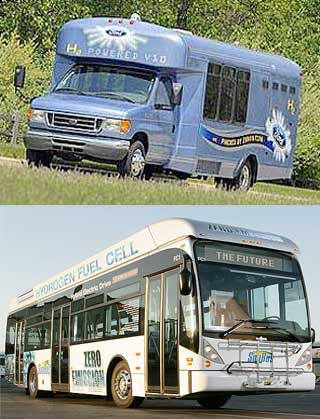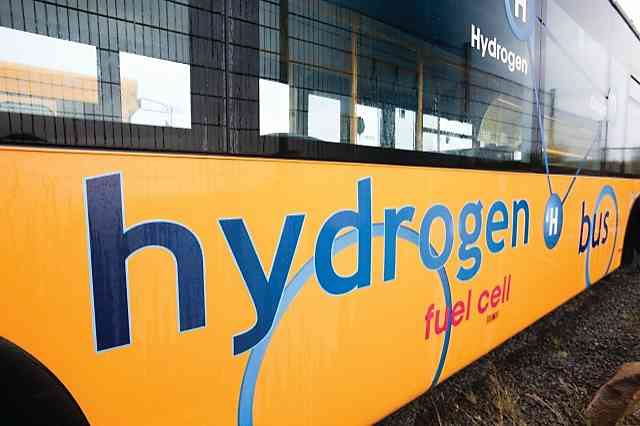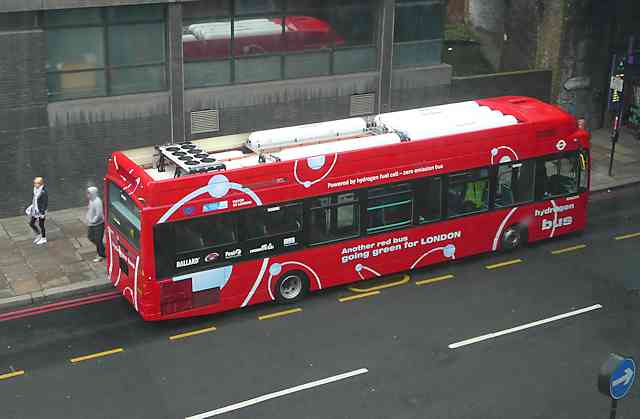Hydrogen Buses
The history of hydrogen buses is murky at best. What is known is that an engineer from Germany, Rudolf Erren started converting internal combustion engines (ICE) in buses and other large vehicles to run on hydrogen and hydrogen mixes in the 1920’s.
|
In 1975, Dr. Roger Billings put into service a hydrogen fueled ICE Winnebago 21-passenger bus which ran between the cities of Provo and Orem, Utah. This hydrogen bus had a Dodge engine and metal hydride tanks.
|
 |
Of course hydrogen buses come in two varieties including ICE vehicles and fuel cell vehicles. Converting a transit bus with an internal combustion engine that was already running gasoline or diesel was far easier than developing a fuel cell.
Fuel cells for other applications such as tractor demonstrators and Apollo missions were developed beginning in the 1950’s and 60’s. But hydrogen fuel cells for buses are a more recent phenomenon.
For instance, the Chicago Transit Authority unveiled the first of their three hydrogen fuel cell buses in 1995. After this there have been many projects in the U. S. and Europe for rolling out prototype hydrogen fuel cell buses for pilot tests.

Hydrogen bus in the UK
In Northern California in the U. S. in the Sacramento, Oakland, San Jose, San Francisco areas companies such as Sunline and AC Transit have rolled out a number of hydrogen fuel cell buses (most of them hybrids as well) and the latest of these versions is operating today.
How CUTE Is That?
In Europe and Australia, the Fuel Cell Bus Club was comprised of three different projects including CUTE, ECTOS and STEP. These projects make up the largest fuel cell bus fleet in the world.
Clean Urban Transport for Europe (CUTE) aimed at testing 27 Citaro hydrogen fuel cell buses in several cities in the European Union. Ecological City Transport System (ECTOS) was centered in Iceland and involved running hydrogen fuel cell buses around the city of Reykjavík, which also has the honor of unveiling the world’s first hydrogen fueling station.
Sustainable Transport Energy for Perth (STEP) involved running three EcoBuses in Western Australia around the city of Perth. The buses went into operation in September 2004.

HyFLEETCUTE hydrogen bus
CUTE, ECTOS and STEP have now been rolled into one project called HyFLEET:CUTE which continues testing hydrogen fuel cell buses among many different cities, gathering and sharing data about fuel cells and hybrid systems.
In July 2006, Ford hydrogen shuttle buses went into production. Ford had intended to produce 20 H2 ICE shuttle buses, which held 12 passengers each. About 15 hydrogen shuttle buses were actually produced (some of the buyers backed out because of finances of lack of fueling stations) between 2006 and 2008, most of which are still in operation today and have logged around 350,000 miles.
Hydrogen fuel and buses are a natural fit. Since most city transit buses run the same routes, this means only a small number (as low as one) hydrogen fueling station is needed to supply the fuel. As the hydrogen fueling infrastructure continues to expand so will bus routes including those that travel to cities farther away and must refuel at a second station.
On this page of hydrogen bus pictures (PDF) there are several photos of both H2ICE and fuel cell buses over the years.
More Information From Our Blog
Written by Hydro Kevin Kantola